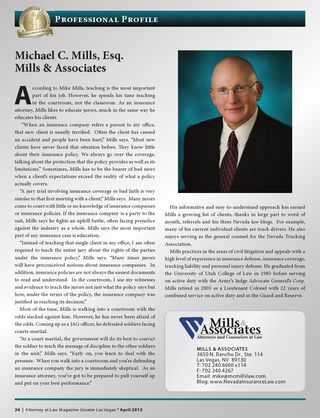 For a few years there, it seemed that there might be hope that not all Nevada on-the-job injuries would be compensable under worker’s compensation. It all started with the case of Rio Suite Hotel & Casino v. Gorsky, 113 Nev. 900, 939 P.2d 60 (Nev. 1997). . In Gorsky, the worker was headed to the time clock to punch out and leave work. As he was walking across the casino on a flat floor, he fell causing injuries to his knees and back. There was nothing on the floor that seemed would pose a fall risk. However, one witnesses testified that Gorsky had said to him that Gorsky’s MS had caused the fall. Another employee saw Gorsky fall on another occasion with no explanation.
For a few years there, it seemed that there might be hope that not all Nevada on-the-job injuries would be compensable under worker’s compensation. It all started with the case of Rio Suite Hotel & Casino v. Gorsky, 113 Nev. 900, 939 P.2d 60 (Nev. 1997). . In Gorsky, the worker was headed to the time clock to punch out and leave work. As he was walking across the casino on a flat floor, he fell causing injuries to his knees and back. There was nothing on the floor that seemed would pose a fall risk. However, one witnesses testified that Gorsky had said to him that Gorsky’s MS had caused the fall. Another employee saw Gorsky fall on another occasion with no explanation.
The Court explained what was needed in order to collect worker’s compensation benefits by citing NRS 616.5015(1).
An injured employee or his dependents are not entitled to receive compensation pursuant to the provisions of this chapter unless the employee or his dependents establish by a preponderance of the evidence that the employee’s injury arose out of and in the course of his employment. (emphasis added).
It’s a two prong test. Not only must the injury happen “in the course” of the employment, it also must “arise out of” the employment. The court explained:
An accident or injury is said to arise out of employment when there is a causal connection between the injury and the employee’s work. In other words, the injured party must establish a link between the workplace conditions and how those conditions caused the injury. Further, a claimant must demonstrate that the origin of the injury is related to some risk involved within the scope of employment. However, if an accident is not fairly traceable to the nature of employment or the workplace environment, then the injury cannot be said to arise out of the claimant’s employment. Finally, resolving whether an injury arose out of employment is examined by a totality of the circumstances. (citations omitted).
939 P.2d at 1046.
Because Mr. Gorsky could not show by a preponderance of the evidence that the fall arose out of his employment, he was denied benefits.
Other cases following Gorsky seemed to be headed in the company’s direction. Take the case of Mitchell v. Clark County School Dist, 121 Nev. 179, 111 P.3d 1104 (Nev. 2005) as an example. Mitchell was a school teacher. She inexplicably fell down a flight of stairs. Everyone agreed that Mitchell’s injuries happened while she was on the job. The question was whether her injuries “arose out of her employment”. Mitchell argued that she should be compensated because she would not have been going down those stairs but for her employment. The court rejected this “positional risk” argument. The court said that an employee should not be compensated just because work causes the employee to face a common risk particular to that work location. Mitchell’s benefits were also denied.
But what the Supreme Court giveth, it also taketh away. The most recent case in the series is Rio All Suite Hotel & Casino v. Phillips, 126 Nev. Adv. Op. 34, 240 P.3d 2 (2010). Phillips was an employee of Rio All Suites. At work, she had to go up and down the stairs to get to the employee break room. Here was her description of what happened:
[W]hen I stepped down on my left foot, it just twisted over…. I never missed a step. I just sat down on the stair that my butt was on, which was a couple up from it. But, my leg just was sitting there. I didn’t lose my balance. I didn’t even slip at all. Just that foot twisted around.
240 P.3d at 3.
It sounds a lot like the description that Mitchell gave. But Mitchell’s inventive attorney argued that while stairs might be a common risk, Phillips’s exposure to them was greater because she faced that work risk on an increased basis. The attorney proved that Mitchell had to go up and down the stair six times in any one shift because there were two flights of stairs between her work location and her break room.
The court explained that:
The act of descending a staircase at work, in and of itself, does not present a greater risk than that faced by the general public; however, when an employee is required to use the stairs more frequently than a member of the general public, she faces an increased risk of injury. Moreover, steps of an unusual height, or the manner in which an employee is required to perform her job may increase her risk of falling on a staircase. (citations omitted).
240 P.3d at 7.
In other words, if a case like this ever came up for your company, the injured worker would be attempting to demonstrate that the worker’s pre-existing condition did not cause the injury and that the workplace put the worker at an increased risk of the type of injury sustained. The trucking company would be trying to show that either a pre-existing condition caused the problem or the exposure to the risk was the same as any other person walking down the street. The Supreme Court does not say how much of an increase is needed. Just that there is an increase. So good luck with that!
If you have questions about this issue, you are not alone. Click here to contact Mills & Associates or give Mike a call at 702-240-6060×114 and let’s see if we can sort it out.
 Follow
Follow Email
Email


